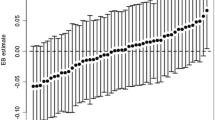Abstract
This study used hierarchical linear models to analyze post-discharge data among 17,130 veterans who received inpatient VA mental health services between 1995 and 2001, in order to determine whether changes in mental health service affected inpatient satisfaction. In models without covariants, half the satisfaction measures increased while the other half indicated no significant change. After adjusting for changes in patient characteristics, however, nine measures indicated no change and seven showed significant declines. Demonstrating the importance of risk-adjustment, satisfaction appeared to increase over time prior to risk adjustment, but declined after adjusting for changes in patient characteristics that were associated with patient satisfaction.
Similar content being viewed by others
REFERENCES
Allen, H.E., Darling, H., McNeill, D.N., & Bastien, F. (1994). The employee health care value survey: Round one. Health Affairs, 13, 25–41.
Bryk, A.S., & Raudenbush, S.W. (1992). Hierarchical linear models. London: Sage.
Cleary, P.D., Edgman-Levitan, S., McMullen, W., & Delbanco, T.L. (1992). The relationship between reported problems and patient summary evaluations of hospital care. Quality Review Bulletin, 18, 53–59.
Cleary, P.D., Edgman-Levitan, S., Roberts, M., Moloney, T.W., McMullen, W., Walker, J.D., & Delbanco, T.L. (1991). Patients evaluate their hospital care: A national survey. Health Affairs, 10, 254–267.
Dickey, B. (1996). The development of report cards for mental health care. In L. Sederer and B. Dickey (Eds.), Outcomes Assessment in Clinical Practice. Baltimore: Williams & Wilkins.
Druss, B.G., Rosenheck, R.A., & Stolar, M. (1999). Patient satisfaction and administrative measures as indicators of the quality of mental health care. Psychiatric Services, 50, 1053–1058.
Huelskamp, P. (2004). Business manager at NRC and Picker Group. Personal communication.
Horvath, A., & Greenberg, L. (1989). Development and validation of the Working Alliance Inventory. Journal of Counseling Psychology, 436, 223–233.
Jenkinson, C., Coulter, A., Bruster, S., Richards, N., & Chandola, T. (2002). Patients' experiences and satisfaction with health care: Results of a questionnaire study of specific aspects of care. Quality and Safety in Health Care, 11, 335–339.
Lasek, R.J., Barkley, W., Harper, D.L., & Rosenthal, G.E. (1997). An evaluation of the impact of nonresponse bias on patient satisfaction surveys. Medical Care, 35, 646–652.
Lebow, J.L. (1982). Consumer satisfaction with mental health treatment. Psychological Bulletin, 91, 244–259.
Moos, R. (1973). Evaluating treatment environments: A social ecological approach. New York: Wiley.
Neale, M.S., & Rosenheck, R.A. (1995). Case manager-client alliance and clinical case management outcome. Psychiatric Services, 46, 719–721.
National Committee on Quality Assurance (NCQA). (1995). Report card pilot project. Washington, DC: The National Committee on Quality Assurance.
National Customer Feedback Center Performance on Customer Service Standards (NCFC). (1994). Recently discharged in-patients: 1994 executive summary report. West Roxbury, MA: VHA National Customer Feedback Center.
Rosenheck, R.A., Banks, S., & Pandiani, J. (2000). Does closing beds in one public mental health system result in increased use of hospital services in other systems? Mental Health Services Research, 24, 183–189.
Rosenheck, R.A., Banks, S., Pandiani, J., & Hoff, R. (2000). Does closing inpatient beds increase the risk of incarceration among users VA of public mental health services? Psychiatric Services, 51, 1282–1287.
Rosenheck, R.A., & Fontana, A. (2001). Impact of efforts to reduce inpatient costs on clinical effectiveness: Treatment of posttraumatic stress. Medical Care, 39, 168–180.
Rosenheck, R.A., & Fontana, A. (2002). African-American and Latino veterans in intensive VA treatment programs for posttraumatic stress disorder. Medical Care, 40, I52–I61.
Rosenheck, R.A., Frisman, L.K., & Essock, S. (2001). Impact of VA bed closures on use of state mental health services. Journal of Behavioral Health Services and Research, 28, 58–66.
Rosenheck, R.A., & Greenberg, G.A. (2002). National mental health program performance monitoring system: Fiscal year 2001 report. West Haven, CT: Northeast Program Evaluation Center.
Rosenheck, R.A., Wilson, N.J., & Meterko, M. (1997). Influence of patient and hospital factors on consumer satisfaction with inpatient mental health treatment. Psychiatric Services, 48, 1553–1561.
Ruggeri, M. (1994). Patients' and relatives' satisfaction with psychiatric services: The state of the art and its measurement. Social Psychiatry and Psychiatric Epidemiology, 29, 212–227.
Author information
Authors and Affiliations
Corresponding author
Rights and permissions
About this article
Cite this article
Greenberg, G.A., Rosenheck, R.A. Consumer Satisfaction with Inpatient Mental Health Treatment in the Department of Veterans Affairs. Adm Policy Ment Health 31, 465–481 (2004). https://doi.org/10.1023/B:APIH.0000036414.17386.73
Issue Date:
DOI: https://doi.org/10.1023/B:APIH.0000036414.17386.73




